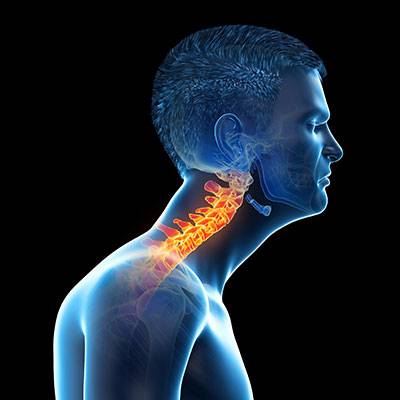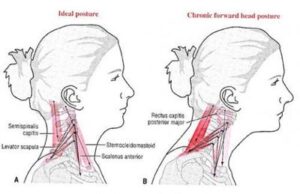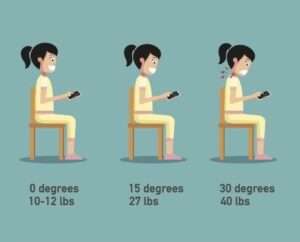

Even before I answer the query, “what are the most common forward head posture symptoms”, let me explain what “forward head” really is.
Well, when your head is sitting far away (in front) of your shoulders then, it is termed as forward head posture. When you sit with your head stretched forwards then, the cervical ligaments tend to weaken.
The cervical ligaments comprise of connective tissues that tend to maintain optimal position of your cervical vertebrae. Moreover, when you suffer from turtle neck (another name for forward neck) then, your neck tends to lose its cervical lordotic curve.
When the cervical lordotic curve weakens, the natural cervical curve of the neck tends to fall behind the plumb line of the head. As your head stretches forward for a prolonged time period, the muscles at the back of the neck get damaged.
This damage is coupled with compression and herniation of the veins and nerves located in front of the neck.
So, in order to fix neck posture, you need to first know the symptoms.
In this article, BestForwardHeadPostureFix research team shall discuss just these in brief:
Forward Head Posture Symptoms Article Contents:
- What is Cervical Spine Destabilization?
- What is “Heavy Head” Caused by Forward Head Posture?
- What are the Most Common Forward Head Posture Symptoms?
- FAQs on Forward Head Posture Symptoms
- Conclusive Analysis
What is Cervical Spine Destabilization?
Also known as cervical spine instability, when your head is constantly pushed forward then, the muscles and surrounding structure of the neck is compromised.
This is when the natural curve of your spine is jeopardized. This also forces the cervical lordotic curve to lose its natural position.
Your head tends to push itself ahead of the cervical curve of your neck.
The end result is weakening of the muscles behind your neck and added pressure being applied to the nerves, veins and arteries located in front of the neck.
The neck is compressed and stretched in an unnatural manner. This is all owing to your nerd neck posture.
If bad neck is not corrected, the nerves of the autonomic nervous system are compressed. The result is breathing issues, indigestion and heart problems.
What is “Heavy Head” Caused by Forward Head Posture?
Heavy head implies to the added pressure that is placed onto your neck for every inch that your head is moved forward. In simpler words, forward head posture tends to shift your neck forward.
When that happens, the weight onto your neck increases. For every inch the neck moves forward, an additional 12 pounds of weight is added onto your spinal column.
The posterior neck ligaments tend to get stretched when you suffer from turtle neck or forward neck or vulture neck. A normal head posture applies 10 to 12 pounds of weight onto your spine.
If your head posture is 2 inches forward than the normal neck posture then, the weight applied to the spine is equivalent to 32 pounds.
Nonetheless, if your forward head posture is 3 inches or more then, the added weight applied to your spine is 42 pounds or even more.
So, the further your head moves forward from the shoulders, the heavier is the weight added to your spine.
What are the Most Common Forward Head Posture Symptoms?
Some of the most common forward head posture symptoms are mentioned below:
Pain in the Neck:
Owing to the added weight being placed onto the spinal column, forward neck does tend to stretch the muscles at the back of the neck.
This awkward stretch tends to cause pain and discomfort in the anterior portion of the neck. It is mainly owing to the unwanted stretch on the muscle that is located right above the hyoid bone.
Interestingly, the muscle above the hyoid bone gets strained because your forward neck is applying 2 to 4 times more weight than what your spine is capable of withstanding.
Cervicogenic Headaches:
Also known as secondary headaches, cervicogenic headache is yet another symptom of vulture neck or crane neck posture. In this situation, the pain initiates in the neck muscle but is felt or experienced in the head.
So, people with forward head posture would experience tension headaches that are similar to migraine. The pain is often accompanied with a stiff neck. Interestingly, the pain may initiate from one side of the neck and shift towards the front portion of your head.
Pain in the Jaw:
Yet another symptom of turtle neck is TMJ. So here, the forward thrust of your neck forces the muscles near the jaw to get stressed. The end result is pain above and around the jaw of the concerned individual.
Almost 12% of all Americans suffer from this pain. TMJ may be caused by several reasons and “forward neck posture” is just one of those reasons.
Scapula Dyskinesis:
Another common symptom of forward neck posture is rounded scapula. This event happens owing to the very simple fact that when added weight is placed onto your spinal column, your shoulder blades tend to bear the brunt of this impact.
With time, your shoulders lose their natural shape and are forced to slope forwards (quite similar to your neck). So, you tend to have rounded shoulders that compromise your overall body posture.
Inability to Breathe Properly:
Another common symptom that has been associated with forward neck posture is breathlessness. Some confuse this with asthma but in reality, your incorrect posture puts undue strain onto your respiratory tract.
Eight nerves in my body were damaged by forward head posture. My arteries and veins on the upper part of the neck got compressed owing to your incorrect head posture. Moreover, undue pressure is always applied to your respiratory tract.
The end result in expansion of the upper chest while the lower chest contracts. This in turn leads to irregular breathing pattern that often turns into breathlessness owing to a damaged pharynx.
Your Body Balance is Compromised:
Bad neck posture tends to jeopardize your body’s natural positioning. In simpler words, when you tend to sit in a bad neck posture for hours every day (laptop, cellphone etc.) then, your body posture is compromised.
This happens in a slow and steady manner. Simply put, when you watch reels on your cellphone for 4 to 6 hours daily or sit with the laptop for a similar duration then, in a few months to a year, you shall develop forward neck posture.
Incorrect cellphone screen position causes text neck and damages your neck and upper back muscles.
Owing to this, the natural balance of your body is compromised.
So, if you are facing issues with your body balance while performing everyday tasks then, you may be suffering from bad neck posture.
FAQs on Forward Head Posture Symptoms
Q-1: How does forward head posture (FHP) affect lung capacity?
A-1: Forward head posture can significantly reduce lung capacity by compressing the diaphragm and ribcage. This compression restricts proper lung expansion, leading to shallower breathing and decreased oxygen intake, which can affect overall respiratory function.
Q-2: Can FHP contribute to temporomandibular joint (TMJ) disorders?
A-2: Yes, FHP can cause strain on the jaw by altering the alignment of the head and neck. This strain affects the temporomandibular joint, potentially resulting in jaw pain, clicking noises, and difficulties with chewing or speaking.
Q-3: What impact does FHP have on balance and proprioception?
A-3: FHP changes the position of the head relative to the body, which can disrupt the body’s ability to sense spatial orientation. This disruption may lead to impaired balance and an increased risk of falling.
Q-4: How does FHP influence the development of osteoarthritis?
A-4: The misalignment caused by FHP increases stress on the cervical spine, accelerating wear and tear on spinal joints. This additional stress can lead to early disc degeneration and the development of osteoarthritis in the neck.
Q-5: Can FHP lead to sleep disturbances?
A-5: Forward head posture often causes discomfort and pain that make it difficult to find a comfortable sleeping position. This discomfort may result in insomnia or fragmented sleep, negatively affecting overall sleep quality.
Conclusive Analysis:
When your head is not aligned with your spine and tends to protrude forwards then, it is a state of forward neck posture.
It has been noticed that people who maintain bad posture while working with media devises tend to spoil their natural neck and head posture.
This is what leads to forward neck posture that needs fixing. Your neck tends to become weak and stiff. Pain and discomfort often accompanies turtle neck.
Nonetheless, you can fix neck posture via certain exercises (such as scapular retraction workouts to fix nerd neck) and making changes to your existing lifestyle.
Finally, do keep the above mentioned symptoms in mind while trying to determine if you are indeed suffering from turtle neck or not.
References:


